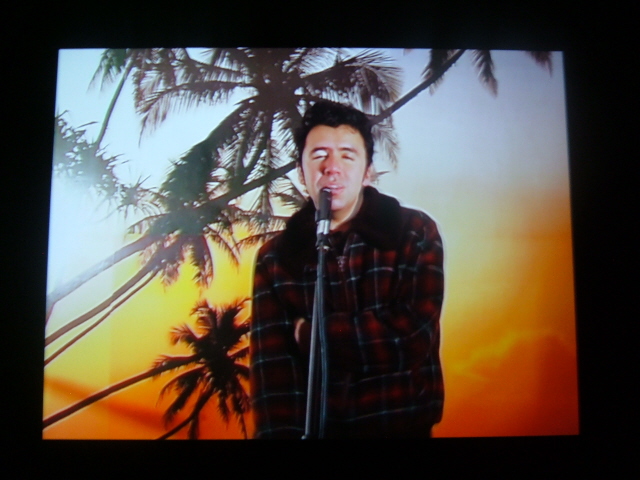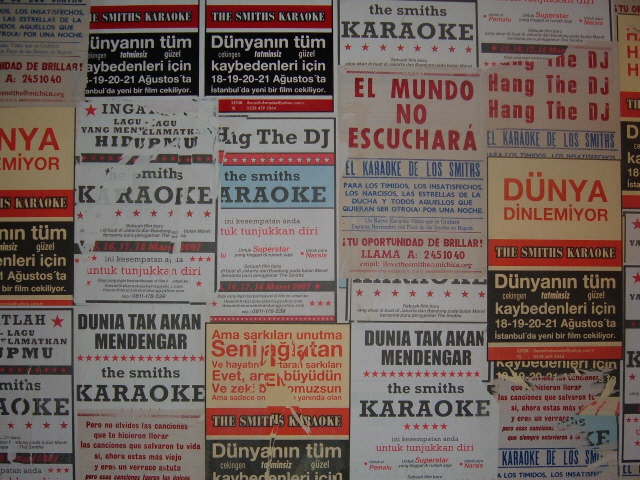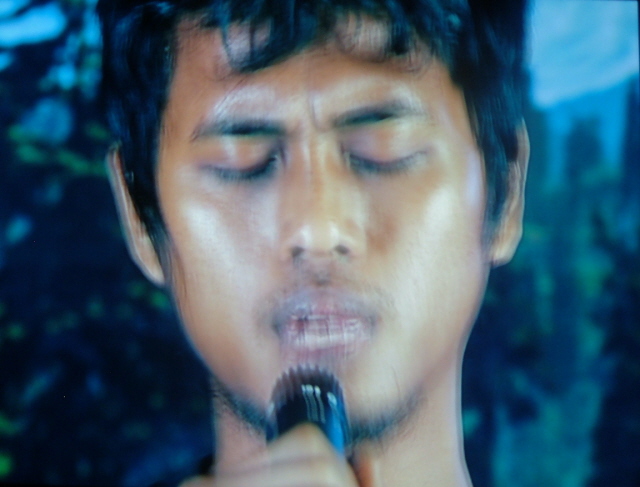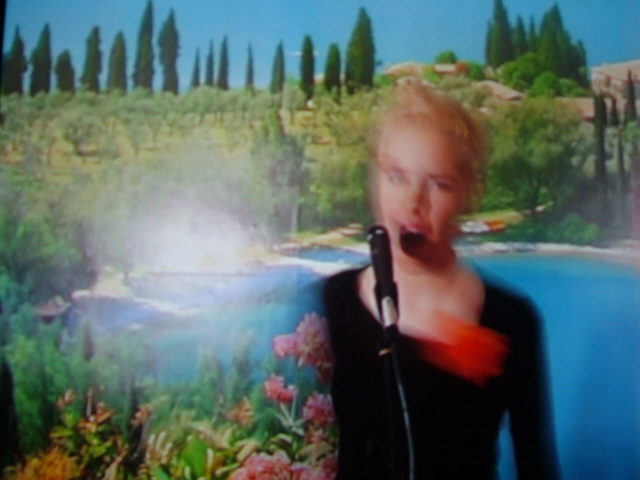
Phil Collins’ “The World Won’t Listen” opened last week with
more fanfare than any other solo art event in Dallas this year. There were TV interviews,
luminary panel discussions, invite dinners, and an after-opening party that
Angstrom impresario David Quadrini made a rare appearance in town to throw at
his otherwise hibernating/defunct space in Fair Park.
I wasn’t up for it (it was a week night, and I owe it to my kids to be awake
for that 8 am class) but I heard that it went till the wee hours, and that the
signature scent of having burned it down in D-Town – namely, that of vomit – was prevalent in the vicinity the next day.
I just got over to see the show today. It surprisingly lives
up to the hype, and instantly overcame my anticipated skepticism. Speaking of
vomit, “The World…” helps wash out the taste of the last DMA Concentration
show, which consisted of a horrendous sculpture by Mark Handforth, ranking as
one of the single worst pieces of contemporary sculpture I’ve seen in a museum in
years/ever.  It looked like the crap the mindless tool-heads in the sculpture
It looked like the crap the mindless tool-heads in the sculpture
department of my alma mater would throw together from junk pulled out of the
scrap pile out back. “Hey, we got boom trucks, torches, welders, fluorescent spray
paint, and a crit in 48 hours. Let’s buy a case of Milwaukee’s Best, smoke a bowl, and rock! Put
in that Zeppelin tape…”
Hey, don’t get me wrong though. I’m all for beer, Led, and
welding. But back then, so my biases are on the table, I was more into casting,
and likely to be listening to Elvis Costello, or the Smiths on my Walkman. Which brings me
back to Collins show. He traveled to Turkey,
Indonesia, and Columbia, and filmed
people singing karaoke to Smiths’ songs. I thought it sounded like a clever
idea, but I am sitting here trying to come to terms with why seeing the actual
piece it moved me so deeply.
I had this friend back in the late ‘90’s. He was
the first guy I knew who really lived on-line, and was always finding obscure
bands and turning me onto them (like a bunch of teenagers from Washington without a
record label called Modest Mouse.) He also happened to be gay. He found out I was a huge Smiths fan, and
sort of seemed offended. “You can’t like them! You’re straight.” Which seemed
odd, because he was outwardly as straight-seeming (or straighter), and our
musical tastes were pretty similar. I didn’t, like, think he should be listening
to disco. Until that moment, it had never struck me that Morrissey’s lyrics
could be construed as particularly homosexual (I know, dumb right?), though of course with that in
mind it wasn’t hard to extrapolate. What he
missed, I guess, was that Morrissey’s expressions of longing, alienation, irony,
and faith in the triumph of human feeling despite life's inevitable disappointments, could be as
applicable to me pining for the girl next door in suburban Denver as they were
to him pining for the boy next door in rural Kentucky – as, similarly, teens in Britain
and the US alike shared the desire for freedom from the soul-numbing regimes of
Reagan and Thatcher.
This is not to mention that the Smiths just could simply
fucking rock.
The other day I found myself surfing Youtube and watched a bunch of
hugely entertaining old Smiths videos and interviews. I never could see that stuff so easily back
in the day. You’d wait long hours to try to catch anything good on MTV, sitting
through endless Journey, Def Leppard, and Huey Lewis videos before you’d get to
something decent. Ah, and then, the payoff! Gems among the swill. REM (we’re
talking Radio Free Europe here, in the Rev. Howard Finsters’ garden,) XTC,
Psychedelic Furs, X, the Cure. I saw those bands and many others, including the
Smiths, at the 1000 seat Rainbow
Music Hall in one long summer
back in 1983, before my freshman year in high school, with Thomas Dolby glasses and
mousse in my hair. The Smiths were, then and now, the best of the lot.
Their appeal has deepened for many into an almost religious
intensity, among some surprising constituents. When I lived in LA, I knew folks
who would attend Morrissey conventions mainly populated by pompadoured Latinos
and hip Latinas. Until the last couple records, after the Smiths I never cared
much for Moz solo. I guess I’d just moved on. I loved the Smiths as much for
the rhythm section of Joyce and Rourke as the songs Marr and Morrissey, anyway.
But I loved his last record so much, I asked Glasstire if I could write a
review. That idea got shot down, but I still say it was my favorite recording from
last year. I’ve read a number of interviews with him and I really enjoy what he
has to say, about art, poetry, politics, and the world. Just like I did when I
was 13, I suppose.
His appeal, and the Smiths', is unique, profound, cult-like, and
demonstrably global.

Shown simultaneously on three large screens separated by sound-absorbing,
black partition walls, Collins’ installation synchs individual tunes on all
three, with singers from each country simultaneously tackling it. I walked in,
past the hallway plastered with posters made for the events in each country (a
nice touch), and it immediately made my heart glad, and my feet move, to hear those tunes that I
know so intimately.  I laughed to watch a tiny cute nerdy chinless Asian kid belt out
I laughed to watch a tiny cute nerdy chinless Asian kid belt out
“Shoplifters of the World,” while next door a painfully uncomfortable guy
twitches his way through it. Something shifted when “There’s a Light that Never
Goes Out” came on, launching three duets – two young Asian hipsters all in
black, some female friends having a ball, and another pair of women, one with
an infant, all of whom dance, groove and happily mumble their way through the song. I
simply, unexpectedly, teared up. Then I laughed. And I sat down and cried a little more. This
pattern was repeated for another 15 minutes, as I walked back and forth between
the screens. What the hell was it that got to me?
Some combination, I guess, of nostalgia, appreciation, admiration, and
something else, I don’t know what. Some persistant romanticism, the thing that had me carry Rilke's Sonnets to Orpheus around for years in my book bag at the same time I loved the Smiths the first round. I do know that I admired the courage of these
people to passionately, ridiculously, so affectionately take on these canonical tunes. I loved
the Columbian guy who had translated his song into Spanish (checking his cheat
sheet occasionally), and sang with this deep flat voice (reminiscent of
Tindersticks), making the song wholly original. He laughed at one point and fluffed up his bangs into a modest emulation of the Founder. On another screen,
a close up of a young guy’s face registered buckets of pathos and passionate
depth.  On the next song, you shift from a pimply nerd on one screen to an
On the next song, you shift from a pimply nerd on one screen to an
incredibly sexy and dangerously self-possessed blond woman who looks ready for
a movie contract already. She showed up ready to own it.
I was simply blown away. I loved it. I don’t know if it
would be nearly as powerful in any other format. None of the videos was
necessarily that striking on its own – especially if you don’t know every song
by heart, as I was kind of amazed to see I did. I doubt that it would have been
as moving for me if they were singing, say, Sinatra. And I wouldn’t even have
gone if they were singing Elvis Presley. So there is that. Also, walking from
one giant projection to the next was such a part of it for me- I don’t know how
they would look on a monitor, or seen singly. But judging it as presented, it’s
one of the best things I’ve seen in ages.




